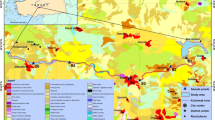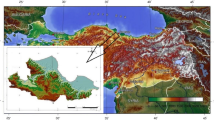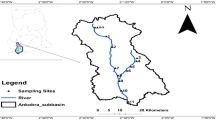Abstract
This study investigated the source and contamination levels of toxic elements (Cd, Cr, As, Pb, Ni and Hg) present in a coastal environment, Paradip—an industrial hub of the east coast of India. The ecological risk assessment indices and human exposure models were used to evaluate the pollution status. Enrichment factor indicated that all the metal(loid)s found in the sediment are mostly derived from the anthropogenic source. According to the sediment quality quotient, 8.33% of sediments have crossed the ERM limit for Ni that can be fatal to biota. Meanwhile, 66.66, 41.66 and 8.33% of sediments have exceeded PEL range for Cr, Ni and As, respectively, that can register frequent lethal toxicity to benthic biota. As had the highest potential ecological harm coefficient (Erf > 80), and Hg had moderate ecological harm coefficient (40 < Erf < 80). Summarily, the sediment quality of this site is moderate to heavily toxic to benthic organisms. The concentration of toxic metals in seawater was below the permissible limit (CCC and CMC) set by USEPA indicating that water is relatively safer for free floating aquatic biota. The health risk index of toxic metal (loid)s present in soils of the residential sites has confirmed that there is a severe non-carcinogenic threat for children (HI child > 1) and a borderline carcinogenic risk for both adult and children. THQCr possesses highest non-carcinogenic threat, which contributed approximately 50% to HI followed by THQAs. The contribution of carcinogenic risk of chromium (CRCr) to TCR is approximately 60%. Cr is the significant contaminant of this site that has highest health effects. Highest exposure risks were associated with ingestion pathway accounting for about 85% of the total for most of the elements.





Similar content being viewed by others
References
Abrahim, G. M. S., & Parker, R. J. (2008). Assessment of heavy metal enrichment factors and the degree of contamination in marine sediments from Tamaki Estuary, Auckland, New Zealand. Environmental Monitoring and Assessment, 136, 227–238.
Agency for Toxic Substances and Disease Registry (ATSDR). (2009). Toxicological profiles. Atlanta: Agency for Toxic Substances and Disease Registry (US). https://www.ncbi.nlm.nih.gov/books/NBK153665/.
Bai, J., Xiao, R., Zhang, K., et al. (2012). Arsenic and heavy metal pollution in wetland soils from tidal fresh water and salt marshes before and after the flow-sediment regulation regime in the yellow river Delta, China. Journal of Hydrology, 450–451, 244–253.
Barbieri, M., Sappa, G., Vitale, S., Parisse, B., & Battistel, M. (2014). Soil control of trace metals concentrations in landfills: A case study of the largest landfill in Europe, Malagrotta, Rome. Journal of Geochemical Exploration, 143, 146–154.
Barik, R. N., Pradhan, B., & Patel, R. K. (2005). Trace elements in groundwater of paradip area. Journal of Industrial Pollution Control, 21(2), 389–396.
Brady, J. P., Ayoko, G. A., Martens, W. N., & Goonetilleke, A. (2015). Development of a hybrid pollution index for heavy metals in marine and estuarine sediments. Environmental Monitoring and Assessment, 187(5), 306.
Brown, E., Skougstad, N. W., & Fishman, M. J. (1974). Methods for collection and analysis of water samples for dissolved minerals and gases. U.S. Department Interior Book-S.P.160.
Caeiro, S., Costa, M. H., Ramos, T. B., Fernandes, F., Silveira, N., Coimbra, A., et al. (2005). Assessing heavy metal contamination in Sado Estuary sediment: An index analysis approach. Ecological Indicators, 5, 151–169.
CCME. (1992). Canadian Council of Ministers of the Environment, Canadian Water Quality Guidelines, prepared by the Task Force on Water Quality Guidelines of the Canadian Council of Ministers of the Environment. Ottawa: Eco-Health Branch.
CCME. (1999). Canadian Council of Ministers of the Environment, Canadian sediment quality guidelines for the protection of aquatic life: Summary tables. Winnipeg: Canadian Council of Ministers for the Environment.
Chen, C. W., Kao, C. M., Chen, C. F., et al. (2007). Distribution and accumulation of heavy metals in the sediments of Kaohsiung Harbour, Taiwan. Chemosphere, 66, 1431–1440.
Chowdhury, A., & Maiti, S. K. (2016). Assessing the ecological health risk in a conserved mangrove ecosystem due to heavy metal pollution: A case study from Sundarbans biosphere reserve, India. Human and Ecological Risk Assessment, 22(7), 1519–1541.
Clark, R. B. (2002). Marine pollution (5th ed.). New York: Oxford University Press.
Cuculić, V., Cukrov, N., Kwokal, Ž., & Mlakar, M. (2009). Natural and anthropogenic sources of Hg, Cd, Pb, Cu and Zn in seawater and sediment of Mljet National Park, Croatia, Estuarine. Coastal and Shelf Science, 81(3), 311–320.
Das, S. K., & Chakrapani, G. J. (2011). Assessment of trace metal toxicity in soils of Raniganj Coalfield, India. Environmental Monitoring and Assessment, 177, 63–71.
Environmental Site Assessment Guideline. (2009). DB11/T 656-2009 (in Chinese).
Ferreira, B. L., & De Miguel, E. (2005). Geochemistry and risk assessment of street dust in Luanda, Angola: Atropical urban environment. Atmos Environment, 39, 4501–4512.
Gang, X., Jian, L., Shaofeng, P., Gang, H., & Xianghuai, K. (2015). Geochemical background and ecological risk of heavy metals in surface sediments from the west Zhoushan Fishing Ground of East China Sea. Environmental Science and Pollution Research, 22, 20283–20294.
Gao, X. L., & Chen, C. T. A. (2012). Heavy metal pollution status in surface sediments of the coastal Bohai Bay. Water Research, 46, 1901–1911.
Gladney, E. S. (1980). Compilation of elemental concentration data for the United States Geological Survey’s six geochemical exploration reference materials (pp. 1–19).
Guang, X., Jian, X., Zhang, Y., Zhao, C., & Wu, Q. (2010). Application of Nemerow Pollution Index in landscape river water quality assessment of Tianjin. In 4th international conference on bioinformatics and biomedical engineering (iCBBE) (pp. 1–4).
Hakanson, L. (1980). Ecological risk index for aquatic pollution control, a sedimentological approach. Water Research, 14(975–1001), 7h.
Han, J. X., Ma, J. H., & Wei, L. F. (2006). Effect of sewage irrigation on content and distribution of heavy metals in alluvial meadow soil—a case study of the Huafei river sewage irrigation region in Kaifeng city soil. The Soil, 38, 292–297.
Hinkey, L. M., & Zaidi, B. R. (2007). Differences in SEM-AVS and ERM-ERL predictions of sediment impacts from metals in two US Virgin Islands marinas. Marine Pollution Bulletin, 54, 180–185.
Ihedioha, J. N., Ukoha, P. O., & Ekere, N. R. (2016). Ecological and human health risk assessment of heavy metal contamination in soil of a municipal solid waste dump in Uyo, Nigeria. Environmental Geochemistry and Health. https://doi.org/10.1007/s10653-016-9830-4.
Islam, M. S., & Tanaka, M. (2004). Impacts of pollution on coastal and marine ecosystems including coastal and marine fisheries and approach for management: A review and synthesis. Marine Pollution Bulletin, 48, 624–649.
Jiang, X., Lu, W. X., Zhao, H. Q., Yang, Q. C., & Yang, Z. P. (2014). Potential ecological risk assessment and prediction of soil heavy-metal pollution around coal gangue dump. Natural Hazards and Earth Systems Sciences, 14, 1599–1610.
Kapsimalis, V., Panagiotopoulos, I., Kanellopoulos, T., Hatzianestis, I., Antoniou, P., & Anagnostou, C. (2010). A multi-criteria approach for the dumping of dredged material in the Thermaikos Gulf, Northern Greece. Journal of Environmental Management, 91, 2455–2465.
Karageorgis, A. P., Anagnostou, C. L., & Kaberi, H. (2005). Geochemistry and mineralogy of the NWAegean Sea surface sediments: Implications for river runoff and anthropogenic impact. Applied Geochemistry, 20, 69–88.
Kaushik, A., Ankur, K., Santosh, M., Shiv, K., & Kaushik, C. P. (2009). Heavy metal contamination of river Yamuna, Haryana, India: Assessment by metal enrichment factor of the sediments. Journal of Hazardous Materials, 164(1), 265–270.
Libes, S. M. (2009). An introduction to marine biogeochemistry (pp. 515–524). Amsterdam: Amsterdam Press.
Long, E. R., & MacDonald, D. D. (1998). Recommended uses of empirically derived sediment quality guidelines for marine and estuarine ecosystems. Human and Ecological Risk Assessment, 4, 1019–1039.
MacDonald, D. D., Ingersoll, C. G., & Berger, T. A. (2000). Development and evaluation of consensus-based sediment quality guidelines for freshwater ecosystems. Archives of Environmental Contamination and Toxicology, 39, 20–31.
McCready, S., Birch, G. F., & Long, E. R. (2006). Metallic and organic contaminants in sediments of Sydney Harbour, Australia and vicinity—A chemical data set for evaluating sediment quality guidelines. Environment International, 32, 455–465.
Meng, M., Shi, J. B., Yun, Z. J., Zhao, Z. S., Li, H. J., Gu, Y. X., et al. (2014). Distribution of mercury in coastal marine sediments of China: Sources and transport. Marine Pollution Bulletin, 88(1–2), 347–353.
Milani, D., Reynoldson, T. B., Borgmann, U., & Kolasa, J. (2003). The relative sensitivity of four benthic invertebrates to metals in spiked-sediment exposures and application to contaminated field sediment. Environmental Toxicology and Chemistry, 22(4), 845–854.
Mohammed, A., May, T., Echols, K., Walther, M., Manoo, A., Maraj, D., et al. (2011). Metals in sediments and fish from sea lots and point Lisas Harbors, Trinidad and Tobago. Marine Pollution Bulletin, 64(1), 169–173.
Nemerow, N. L. (1991). Stream, lake, estuary, and ocean pollution. New York: Reinhold Publishing Co.
Nigro, A., Sappa, G., & Barbieri, M. (2017). Application of boron and tritium isotopes for tracing landfill contamination in groundwater. Journal of Geochemical Exploration, 172, 101–108.
Phull, B. (2010). Marine corrosion. In: R. A. Cottis et al. (Eds.), Shreir’s corrosion (4th Ed., Vol. 2, pp. 1107–1148). Amsterdam: Elsevier.
Satapathy, D. R., & Panda, C. R. (2015). Spatio-temporal distribution of major and trace metals in estuarine sediments of Dhamra, Bay of Bengal, India—its environmental significance. Environmental Monitoring and Assessment, 187, 4133.
Satapathy, S., & Panda, C. R. (2017). Toxic metal ion in seafood: Meta-analysis of human carcinogenic and non-carcinogenic threat assessment, a geomedical study from Dhamra and Puri, Odisha. Human and Ecological Risk Assessment: An International Journal, 23(4), 864–878.
Sharma, R. K., Agrawal, M., & Marshall, F. M. (2007). Heavy metal contamination of soil and vegetables in suburban areas of Varanasi, India. Ecotoxicology and Environmental Safety, 66, 258–266.
Simeonova, V., Stratisb, J. A., Samarac, C., Zachariadisb, G., Voutsac, D., Anthemidis, A., et al. (2003). Assessment of the surface water quality in Northern Greece. Water Research, 37, 4119–4124.
Sobha, V., & Anish, M. (2003). Imprints of environmental pollution on laterite/clay and groundwater of Eloor-Kalamassery Industrial Belt, Kerala State, India. Environmental Geology, 44, 914–918.
Sun, Y., Zhou, Q., Xie, X., et al. (2010). Spatial, sources and risk assessment of heavy metal contamination of urban soils in typical regions of Shenyang, China. Journal of Hazardous Materials, 174, 455–462.
Toth, G., Hermann, T., Dasiva, M. R., & Montanarella, L. (2016). Heavy metals in agricultural soils of the European union with implications for food safety. Environment International, 88, 299–309.
Turekian, K. K., & Wedopohl, K. H. (1961). Distribution of the elements in some major units of the earths crust. Geological Society of America Bulletin, 72, 175–192.
USEPA. (1989). Risk assessment guidance for superfund, vol 1. Human health evaluation. Washington: Office of Emergency and Remedial Response.
USEPA. (1996). Soil screening guidance: Technical background document. Washington: Office of Solid Waste and Emergency Response.
USEPA. (2011a). Screening level (RSL) for chemical contaminants at superfoundsites. Washington: Environmental Protection Agency.
USEPA. (2011b). USEPA regional screening level (RSL) summary table: November 2011. http://www.epa.gov/regshwmd/risk/human/index.htm. Last update 6th.
USEPA (Environmental Protection Agency). (2009). National recommended water quality criteria. Washington: Office of Water, Office of Science and Technology.
Violitzis, C., Arditsoglou, A., & Voutsa, D. (2009). Elemental composition of suspended particulate matter and sediments in the coastal environment of Thermaikos Bay, Greece: Delineating the impact of inland water and waste water. Journal of Hazardous Materials, 166, 1250–1260.
Wang, J., Liu, R., Zhang, P., Yu, W., Shen, Z., & Feng, C. (2014). Spatial variation, environmental assessment and source identification of heavy metals in sediments of the Yangtze River Estuary. Marine Pollution Bulletin, 87, 364–373.
Xiao, R., Bai, J., Wang, Q., et al. (2011). Assessment of heavy metal contamination of wetland soils from a typical aquatic terrestrial ecotone in Haihe River Basin, north China. CLEAN – Soil, Air, Water, 39, 612–618.
Yi, Y., Yang, Z., & Zhang, S. (2011). Ecological risk assessment of heavy metals in sediment and human health risk assessment of heavy metals in fishes in the middle and lower reaches of the Yangtze River basin. Environmental Pollution, 159(10), 2575–2585. https://doi.org/10.1016/j.envpol.2011.06.011.
Zhao, L., Xu, Y. F., Hou, L., Shangguan, Y. X., & Li, F. S. (2014). Source identification and health risk assessment of metals in urban soils around the Tanggu chemical industrial district, Tianjin, China. Science of the Total Environment, 468–469, 654–662.
Zhou, F., Guo, H., & Hao, Z. (2007). Spatial distribution of heavy metals in Hong Kong’s marine sediments and their human impacts: A GIS-based chemometric approach. Marine Pollution Bulletin, 54, 1372–1384.
Acknowledgements
This work was supported by the Ministry of Earth Science (MoES), Govt of India, under the Project No. GAP-004. Thanks to the COMAPS team members for their cooperation in data preparation and sampling. Further gratitude is extended to two anonymous reviewers for their valuable suggestions in modification of the manuscript.
Author information
Authors and Affiliations
Corresponding author
Electronic supplementary material
Below is the link to the electronic supplementary material.
Rights and permissions
About this article
Cite this article
Satapathy, S., Panda, C.R. Source identification, environmental risk assessment and human health risks associated with toxic elements present in a coastal industrial environment, India. Environ Geochem Health 40, 2243–2257 (2018). https://doi.org/10.1007/s10653-018-0095-y
Received:
Accepted:
Published:
Issue Date:
DOI: https://doi.org/10.1007/s10653-018-0095-y




